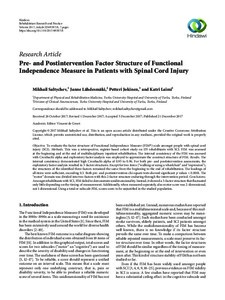Pre- and Postintervention Factor Structure of Functional Independence Measure in Patients with Spinal Cord Injury
Mikhail Saltychev; Janne Lähdesmäki; Petteri Jokinen; Katri Laimi
Pre- and Postintervention Factor Structure of Functional Independence Measure in Patients with Spinal Cord Injury
Mikhail Saltychev
Janne Lähdesmäki
Petteri Jokinen
Katri Laimi
HINDAWI LTD
Julkaisun pysyvä osoite on:
https://urn.fi/URN:NBN:fi-fe2021042717945
https://urn.fi/URN:NBN:fi-fe2021042717945
Tiivistelmä
Objective. To evaluate the factor structure of Functional Independence Measure (FIM (R)) scale amongst people with spinal cord injury (SCI). Methods. This was a retrospective, register-based cohort study on 155 rehabilitants with SCI. FIM was assessed at the beginning and at the end of multidisciplinary inpatient rehabilitation. The internal consistency of the FIM was assessed with Cronbach's alpha and exploratory factor analysis was employed to approximate the construct structure of FIM. Results. The internal consistency demonstrated high Cronbach's alpha of 0.95 to 0.96. For both pre- and postintervention assessments, the exploratory factor analysis resulted in 3-factor structures. Except for two items ("walking or using a wheelchair" and "expression"), the structures of the identified three factors remained the same from the beginning to the end of rehabilitation. The loadings of all items were sufficient, exceeding 0.3. Both pre- and postintervention chi-square tests showed significant p values < 0.0001. The "motor" domain was divided into two factors with this 2-factor structure enduring through the intervention period. Conclusions. Amongst rehabilitants with SCI, FIM failed to demonstrate unidimensionality. Instead, it showed a 3-factor structure that fluctuated only little depending on the timing of measurement. Additionally, when measured separately, also motor score was 2-dimensional, not 1-dimensional. Using a total or subscale FIM, scores seem to be unjustified in the studied population.
Kokoelmat
- Rinnakkaistallenteet [27094]
